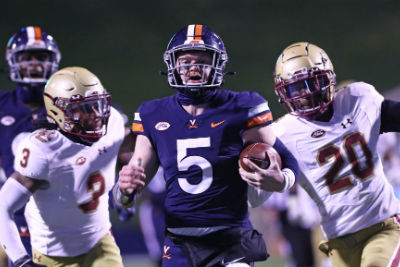Armstrong makes strides on his passing game, decision making in UVA Spring
By Jerry Ratcliffe

Brennan Armstrong races to the end zone for a third quarter touchdown in UVA’s 43-32 win over Boston College. Photo courtesy Atlantic Coast Conference (Erin Edgerton/Daily Progress).
If Virginia football is to successfully defend its 2019 ACC Coastal Division crown this fall, it’s a must that Brennan Armstrong delivers.
The Ohio native did a solid job in his first season as a starter in 2020. It was on-the-job training as he took over the reins from record-setting quarterback Bryce Perkins.
While he was the Cavaliers leading rusher with 552 yards, he also managed to pass for 2,117 yards and 18 touchdowns, completing 58.5 percent of his passes and throwing 11 interceptions. Those numbers tied him for the FBS lead with most single-season games (six) with 200+ yards passing and 45+ yards rushing. He was also third in the ACC and No. 18 nationally with 296.6 yards of total offense per game.
Not bad for a rookie, but Armstrong is going to have to take it up a couple of notches this fall when offensive coordinator Robert Anae hands him the keys to an offense that appears to be loaded with playmakers.
Armstrong’s passing percentage has to come up and his interception numbers have to go down.
Six of his 11 interceptions occurred in his first three games as starter, meaning that in his remaining six games he was picked off only five times. In seven of his nine games, the lefty threw for at least 200 yards, five times surpassing the 250 mark while throwing for 383 against Abilene.
In a postgame chat following UVA’s Spring Game last weekend, Armstrong talked about the strides he had made this offseason.
“Just knowing my progressional reads better but also picking up on keys with our defense, when they rotate a certain way so that I can get my eyes directed to another spot,” Armstrong said. “That allows me to transition to different routes. That’s been a lot quicker as well as getting the ball out faster.”
All of that is what coaches describe as the game slowing down for a quarterback. His vision, his sense, his timing improves.
If he gets the ball to his receivers quicker, that means they have more time to shake a defender and produce more yards after catch, which is what the really good offenses take advantage of over the course of a season.
Armstrong should have a near full complement of weapons this fall. While the Cavaliers lost star sophomore wide receiver Lavel Davis, Jr., to a torn ACL during spring drills, there are plenty of other targets.
Billy Kemp IV, a thorn in most secondary’s saddles last season, returns along with Keytaon Thompson, a dual-threat quarterback turned receiver last campaign. Joining that duo is Ra’Shaun Henry, who stepped up his game midseason last year and who enjoyed a terrific spring, in addition to the long-awaited arrival of sophomore Dontayvion Wicks, a Louisiana-bred receiver with great skill and promise, who was sidelined last season due to an injury.
If that isn’t enough, there’s 6-foot-7 tight end Jalani Woods, who was Oklahoma State’s starter last season. True freshman Ahmaad Foston was UVA’s best receiver out of the backfield in the spring.
With that in mind, along with the entire offensive line returning intact, and three solid running backs, this could be the most dangerous Virginia offense, stem to stern, in years.
Armstrong believes in those teammates.
“I think we can be the best offense in the ACC, honestly, with the weapons we have, the line that’s back, the running backs, the depth we have at running back, which will allow them to run even harder and do different things, and the skill sets we have in the backfield, too,” Armstrong said. “And, obviously I still have my feet with me, I can still scramble and do all those other things that I’m accustomed to.
“It can be pretty dangerous and I’m excited because this is just the beginning of the offseason and we have a big summer workout coming up and fall camp. I’m super excited where we’re at now and we’re just going to continue to get better.”
One cannot discount Armstrong’s running ability on designed plays and his scrambling tactics. Of his 552 rushing yards last season, 205 of them were attributed to his scrambling skills, an average of 24.1 yards per game, not that much different than predecessor Perkins’ 24.9 yards scrambling per game for the 2019 Coastal Division champions. When a quarterback can turn a potential sack into a first down and keep drives alive, what a dangerous weapon he can be. He can also keep plays alive, giving receivers to readjust their routes and get open downfield.
“The receivers and I are just starting to get more comfortable with the scramble drill, and if I could take off anywhere, start to get down the field i different spots, just also being smart,” Armstrong said.
Several of the receivers said they have developed great chemistry with the left-handed quarterback thus far and expect that to improve over the summer’s voluntary passing drills.
As far as cutting down on interceptions, Armstrong believes he has progressed in that department, too.
“Not turning the ball over is the biggest thing,” he said. “It’s just essential. Decision-making, quicker thoughts in my head, when you know something happens, a play breaks down, I’ve got to scramble, do something, but when something’s not there, don’t force it. Just move off, get to another play, just scramble and use my feet.”
In those situations, Armstrong has been highly effective, catching the defense off guard, on its heels. Also to his advantage is his toughness. While coaches have attempted to convince him to slide or run out of bounds, Armstrong is still sometimes tempted to run over a defender.













